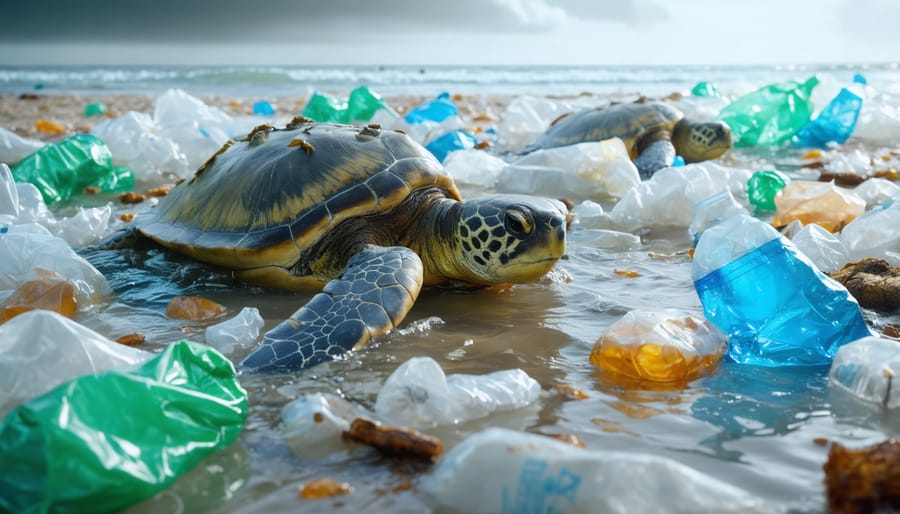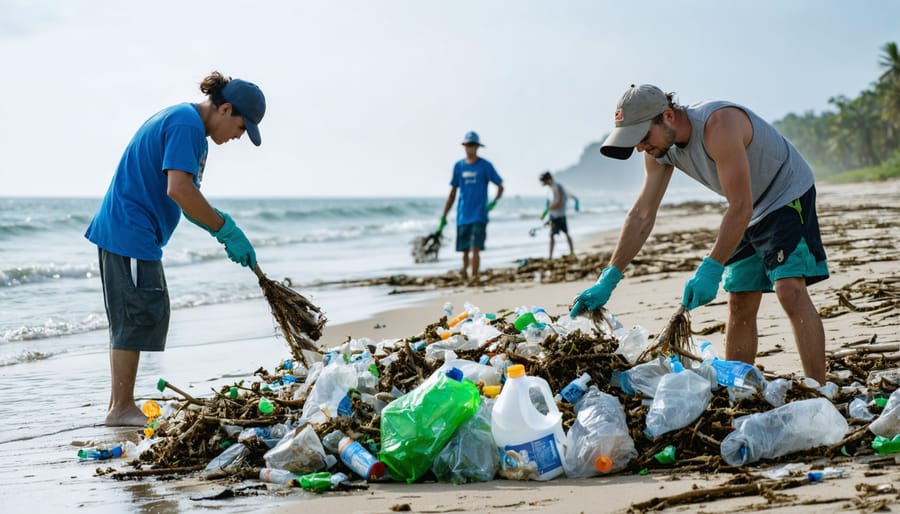
Marine pollution poses an urgent threat to the rich tapestry of life in our oceans. From discarded fishing nets ensnaring sea turtles to microplastics infiltrating the tiniest plankton, the devastating impact of pollution reverberates throughout the delicate marine ecosystem. As toxic chemicals accumulate in the tissues of whales and seabirds, coral reefs suffocate beneath blankets of debris, and once-vibrant habitats turn into lifeless underwater wastelands. The time for action is now. By understanding the scope of this crisis and uniting in our efforts to combat pollution at its sources, we hold the power to restore balance to our oceans and preserve the incredible diversity of life beneath the waves for generations to come. In this article, we will explore the pervasive problem of marine pollution, its devastating consequences for biodiversity, and crucially, what each of us can do to be part of the solution.
The Scope of Marine Pollution
Chemical Pollutants
Chemical pollutants pose a significant threat to marine biodiversity. Oil spills, such as the devastating Deepwater Horizon spill in 2010, can coat wildlife in toxic crude oil, leading to suffocation, poisoning, and long-term health issues. Industrial runoff containing heavy metals, persistent organic pollutants (POPs), and microplastics can accumulate in the tissues of marine organisms, causing hormone disruption, reproductive problems, and even death. Pesticides and herbicides from agricultural runoff can create “dead zones” in coastal areas, depleting oxygen levels and killing fish, crustaceans, and other marine life. These chemicals can also bioaccumulate up the food chain, ultimately harming larger predators like sharks, whales, and even humans who consume contaminated seafood. The impact of chemical pollutants on marine ecosystems is far-reaching and long-lasting, emphasizing the urgent need for stricter regulations, improved waste management, and a transition to more environmentally friendly practices in industries worldwide. By reducing our reliance on harmful chemicals and investing in clean technologies, we can help protect the incredible biodiversity of our oceans for generations to come.
Plastic Pollution
The pervasive presence of plastic waste in our oceans has reached alarming levels, posing a dire threat to the delicate balance of marine biodiversity. Discarded plastic items, from grocery bags to fishing nets, find their way into the ocean through various channels, including improper waste management and storm drain runoff. Once in the water, these plastics break down into smaller particles known as microplastics, which can persist in the environment for centuries. Marine life, from tiny plankton to majestic whales, falls victim to the insidious effects of plastic pollution.
Ingestion of plastic debris by marine animals leads to malnutrition, digestive blockages, and even starvation. Entanglement in abandoned fishing gear, a phenomenon known as “ghost fishing,” causes injury, suffocation, and death for countless creatures. The impact reverberates through the entire marine ecosystem, disrupting food chains and altering habitats. Moreover, toxic chemicals absorbed by plastics can bioaccumulate in the tissues of marine life, potentially causing long-term health effects and even entering the human food chain. Urgent action is needed to stem the tide of plastic pollution and protect the precious biodiversity of our oceans for generations to come.
Biodiversity Under Threat
Endangered Species
Marine pollution poses a severe threat to numerous endangered species, pushing them closer to the brink of extinction. Among the most vulnerable are several species of whales, such as the North Atlantic right whale, with only around 400 individuals remaining. These majestic creatures often become entangled in abandoned fishing gear or collide with ships, leading to injuries and fatalities. Sea turtles, including the critically endangered Hawksbill and Kemp’s Ridley turtles, mistake floating plastic debris for food, causing blockages and starvation. Coral reefs, home to a quarter of all marine life, face bleaching and death due to rising sea temperatures and ocean acidification, exacerbated by pollutants. The vaquita porpoise, found only in the Gulf of California, is on the verge of disappearing, with fewer than 10 individuals left, largely due to illegal gillnet fishing. As pollution continues to degrade habitats and disrupt food chains, many more marine species may face a similar fate. It is crucial that we act now to reduce pollution and protect these irreplaceable members of our ocean ecosystems before it is too late.


Coral Bleaching
Coral reefs, the rainforests of the sea, are facing an alarming threat from chemical and thermal pollution. When water temperatures rise above normal levels or when pollutants such as pesticides, herbicides, and heavy metals contaminate the water, corals expel the symbiotic algae living within their tissues, leading to a phenomenon known as coral bleaching. As a result, the once-vibrant corals turn white and become more susceptible to disease and death.
The loss of coral reefs has far-reaching consequences for marine biodiversity. These ecosystems are home to an estimated 25% of all marine life, providing shelter, food, and breeding grounds for countless species. When corals die, the intricate web of life they support begins to unravel. Fish populations decline, affecting the livelihoods of coastal communities that depend on them for food and income. Moreover, the absence of healthy coral reefs leaves shorelines vulnerable to erosion and storm damage, putting coastal habitats and human settlements at risk.
To address this crisis, urgent action is needed to reduce pollution and mitigate the impacts of climate change. By making conscious choices in our daily lives, supporting conservation efforts, and advocating for stronger environmental policies, we can all play a part in protecting these invaluable ecosystems for generations to come.
Food Web Disruption
When key species in the marine food web are lost due to pollution, it can trigger a domino effect of cascading consequences. Apex predators like sharks, whales, and tuna help maintain balance by controlling prey populations. If pollution decimates their numbers, prey species may explode, leading to overgrazing and habitat destruction. Conversely, a drop in primary producers like phytoplankton due to toxic pollutants can starve entire food chains. These microscopic organisms form the foundation of marine ecosystems, producing oxygen and serving as a vital food source.
The intricate connections between species mean that the loss of even one can have far-reaching impacts. For example, sea otters play a crucial role in keeping kelp forests healthy by controlling sea urchin populations. Without otters, urchins can devour kelp unchecked, turning vibrant forests into barren seascapes. This loss of habitat affects countless species that depend on kelp for shelter and sustenance.
Protecting keystone species is essential for maintaining the delicate balance of marine ecosystems. By reducing pollution and supporting conservation efforts, we can help prevent the unraveling of complex food webs that have evolved over millions of years. It’s up to us to be responsible stewards of the ocean and preserve its biodiversity for generations to come.
Solutions and Conservation Efforts
International Agreements
Several international agreements aim to tackle marine pollution and protect biodiversity. The United Nations Convention on the Law of the Sea (UNCLOS) provides a legal framework for conservation and pollution control. The Global Programme of Action for the Protection of the Marine Environment from Land-based Activities (GPA) is a non-binding agreement targeting major pollutant sources. Regional Seas Conventions and Action Plans cover specific areas, fostering cooperation among neighboring countries. The International Convention for the Prevention of Pollution from Ships (MARPOL) regulates ship-based pollution. The Stockholm and Rotterdam Conventions control persistent organic pollutants and hazardous chemicals. While progress has been made, challenges remain in implementation and enforcement. Stronger global commitment and collaboration are crucial to effectively combat marine pollution and safeguard biodiversity for future generations.
Individual Actions
Here are some practical steps you can take in your daily life to reduce pollution and support marine conservation:
- Reduce your use of single-use plastics like straws, plastic bags, and water bottles. Opt for reusable alternatives whenever possible. Properly dispose of or recycle any plastic waste.
- Be a conscious consumer. Look for products with minimal packaging and avoid products containing microbeads. Choose sustainable seafood options certified by organizations like the Marine Stewardship Council.
- Conserve water and energy. Turn off lights and electronics when not in use, take shorter showers, and fix any leaks. The less water and energy you use, the less wastewater and fewer pollutants end up in the ocean.
- Use environmentally-friendly products. Choose biodegradable, non-toxic cleaning products, detergents, and personal care items. Avoid products with harmful chemicals that can end up in waterways.
- Dispose of waste properly. Never litter or flush trash down the toilet. Participate in local recycling programs and hazardous waste collection days. Properly dispose of items like batteries, electronics, and medications.
- Support organizations working to protect the oceans. Donate to reputable marine conservation groups or participate in beach cleanups and other volunteer opportunities. Small actions add up to a big impact when we work together.
By making simple changes in your daily habits and spreading awareness, you can be part of the solution. Every action counts in the fight against marine pollution. Together, we can create a cleaner, healthier ocean for the incredible biodiversity that calls it home. Dive deeper into how readers can help protect our oceans and preserve the wonders of marine life for generations to come.

Conclusion
The devastating impact of pollution on marine biodiversity is a critical issue that demands our immediate attention and collective action. As we have seen, the accumulation of plastic waste, chemical runoff, oil spills, and other pollutants in our oceans is causing irreparable harm to countless species and fragile ecosystems. From the heartbreaking entanglement of marine mammals in discarded fishing gear to the toxic effects of microplastics on the tiniest plankton, the consequences are far-reaching and potentially irreversible.
However, amidst this sobering reality, there is still reason for hope. Around the world, dedicated scientists, conservationists, and concerned citizens are working tirelessly to combat pollution and protect marine life. Through beach cleanups, sustainable fishing practices, innovative recycling solutions, and education initiatives, we have the power to make a difference. Every action, no matter how small, contributes to the greater goal of preserving the incredible diversity of life that thrives beneath the waves.
As we move forward, it is crucial that we prioritize the health of our oceans and the countless species that call them home. By working together, supporting conservation efforts, and making conscious choices in our daily lives, we can turn the tide against pollution and ensure a thriving future for marine biodiversity. The road ahead may be challenging, but with determination, collaboration, and a shared love for the incredible creatures that inhabit our oceans, we can make a lasting impact and secure a brighter tomorrow for all.
jessica
Ava Singh is an environmental writer and marine sustainability advocate with a deep commitment to protecting the world's oceans and coastal communities. With a background in environmental policy and a passion for storytelling, Ava brings complex topics to life through clear, engaging content that educates and empowers readers. At the Marine Biodiversity & Sustainability Learning Center, Ava focuses on sharing impactful stories about community engagement, policy innovations, and conservation strategies. Her writing bridges the gap between science and the public, encouraging people to take part in preserving marine biodiversity. When she’s not writing, Ava collaborates with local initiatives to promote eco-conscious living and sustainable development, ensuring her work makes a difference both on the page and in the real world.
